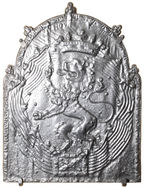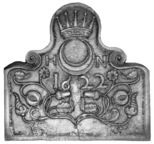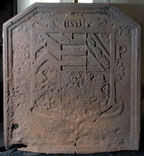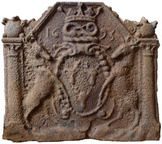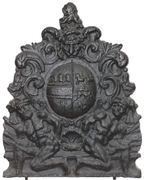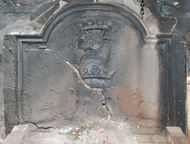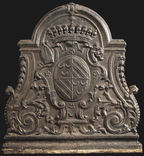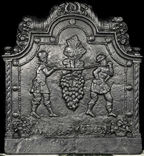-
573
Description: Rectangular with fillet sides and bottom; scrolled foliage on outside edges; date in narrow rectangular panel at bottom; central pictorial representation of four historical figures (see below), three male in mid-17th century armour, and one female; tripple arched top formed of rococo scrolls, a putto forming the middle arch.
Notes: The inscription may relate to the defeat of the Spanish at s'Hertogenbosch (den Bosch - ENDE BUSH) in 1629, and Wesel. von den Driesch states that the figures, from left to right, are: Prinz Fredrik Henrik of Oranje, his daughter, Luise Henriette, Prince Maurice of Nassau, and the Elector Friedrich Wilhelm of Brandenburg, who married Luise Henriette. German craftsmanship may account for the incorrect spelling of Dutch names. Mitford collection, Petworth House.
Copies of this fireback are known.
Inscription: PRESNTZI VAN WESEL ENDE BVSH / 1667
- Decoration tags:
- rectangular with three arches (shape)
- complex individual (edging)
- whole carved pattern
- pictorial
- historical
- royal
- text
- humans
Manufactured: in 1667 possibly in the Siegerland area of Germany.
Current location: Petworth House, Petworth, West Sussex, England.
Museum number: NT/PET/M/64 (part of the National Trust museum group)
- Attached to series:
- 'Dutch' Miscellaneous Firebacks
- Commemorative firebacks
-
580
Description: Arched rectangular shape with fillet edging and a repeated line and concentric semi-circle design; wicker enclosure with gate at bottom, overlaid with a lion rampant surmounted by a crown.
Notes: The enclosure is the Garden of Holland (Hollandse Tuin) and the lion the badge of the States General of the Netherlands; on the shoulders of the plate, and on three other positions equally spaced around the arch, repeated small fleurs-d-lys. Mitford collection, Petworth House.
Inscription: ...E HOV...
- Decoration tags:
- rectangular with round arch (shape)
- complex individual (edging)
- whole carved pattern
- heraldic
- text
- animals
- objects
Manufactured: in the mid- to late-17th century possibly in the Siegerland area of Germany.
Current location: Petworth House, Petworth, West Sussex, England.
Museum number: NT/PET/M/71 (part of the National Trust museum group)
- Attached to series:
- 'Dutch' Miscellaneous Firebacks
- 'Dutch' Garden of Holland firebacks
-
584
Description: Of unique design; quasi-arched rectangular shape; ribbon border, curled on each side of the neck. Symmetrical arrangement of plant tendrils with acorns, oak leaves, pomegranates and other leaves across the rectangular base; above and centrally placed are the date, over which are the initials either side of a crescent moon, surmounted by an earl’s coronet.
Notes: The initials, H N, are thought to refer to Henry, 9th Earl of Northumberland, and the date to his release from the Tower of London following his 17 years’ imprisonment for alleged involvement in the Gunpowder Plot.
Copies of this fireback are known.
Inscription: H N / 1622
- Decoration tags:
- rectangular with round arch (shape)
- complex individual (edging)
- whole carved pattern
- heraldic
- text
- plants
Manufactured: in 1622 probably at Frith Furnace, Northchapel in the Weald area of England.
Current location: Petworth House, Petworth, West Sussex, England.
Museum number: 485698 (part of the National Trust museum group)
- Attached to series:
- Personal firebacks
- Petworth lettering series
-
924
Description: Canted rectangle; elaborate cavetto moulded edging (top and sides); strapwork shield with a demi-flower at each side, between initials; arms quarterly of six, 1st Or two chevronels Gules, on a canton of the last a mullet of the first (Pope); 2nd Argent three bars Gules, on a canton ermine a bend of lozenges of the second (Walshe); 3rd Sable three laurel leaves in bend Or between two bendlets Argent (Waller); 4th Azure a chevron between three crosses Moline Argent (Lansdale); 5th Ermine on a bend Gules three lions' heads erased Or (Weston); 6th Azure a lion rampant Or supporting a cross pat?e fitch?e of the second (Pichingham).
Notes: The lower part of the shield is revealed more clearly in another casting. The date above the shield has been inserted before casting and differs slightly from another example of the same back.
Copies of this fireback are known.
Inscription: 1625 / S P
Arms: Pope (Sackevile Pope (b. 1589) of Hendall, in Buxted, Sussex)
- Decoration tags:
- rectangular with canted top corners (shape)
- complex individual (edging)
- whole carved pattern
- date stamp
- armorial
- text
Manufactured: in 1625 in the Weald area of England.
Current location:, L.T.C. Rolt - Life, Work, Legacy A Joint Ironbridge Gorge Museum Trust / Keele University Conference 9th - 11th May 2024 Ironbridge Gorge Museum, Coalbrookdale, Shropshire Click here for details.
- Attached to series:
- Low relief armorial series
- Personal armorial firebacks
-
818
Description: Quasi-arched rectangular shape; on a ground, an armorial achievement comprising a central cartouche on which is an oval shield bearing the arms of the Cavendish family, with graduated bead edging; supporters, two stags rampant; above the cartouche, on a wreath a coiled snake crest surmounted by an earl’s coronet; the date split either side of the crest; to each side, a column with foliate capital supporting a three-sided arch with ovolo-moulded edging, on each shoulder of which is a flaming orb.
Notes: The arms are those of the Earls of Devonshire. However, the date relates to William Cavendish (1640-1707), previously 4th Earl and created 1st Duke of Devonshire in 1694. An earlier casting (no. 246) has a date of 1657, the second pair of numerals having been changed. Christie's auction 3 Dec 2014 lot 15 (dated incorrectly as 1693) (£1,875).
Inscription: 1695
Arms: William Cavendish, 1st Duke of Devonshire, as 4th Earl of Devonshire
- Decoration tags:
- rectangular with three-facetted arch (shape)
- complex individual (edging)
- whole carved pattern
- individual numbers
- armorial
- text
Manufactured: in 1695 in England.
Current location: not known.
- Attached to series:
- Personal armorial firebacks
- Cavendish arms series
-
965
Description: Upon a moulded base plinth, wide scrolled side double fillets with foliage about the scrolls and suspended bell flowers in chain above; central foliate cartouche behind an oval shield surmounted by a viscomte's coronet; on top, an arch rising from horizontal moulding on each side.
Notes: Blazon: Azure, a chevron Argent between three estoiles Or, all surmounted by a bar of the second; characteristic of designs illustrated by architects such as Daniel Marot; the texturing on the shield indicates the azure tincture. See Carpentier p. 234, fig. 644.
Arms: Besset de la Chapelle
- Decoration tags:
- rectangular with round arch (shape)
- complex individual (edging)
- whole carved pattern
- armorial
Manufactured: in the late-17th to early-18th century in France.
Current location: not known.
Citation: Carpentier, H., 1912, Plaques de Cheminées (Paris, published by the author).
- Attached to series:
- Foreign armorial firebacks
-
757
Description: Within a surround of symmetrical swirled foliage, an oval armorial shield carried by two naked, kneeling male figures seated on a broad pedestal, between them a scallop shell; above the shield a lion’s face surmounted by a crest of a lion’s head erased. The arms are of Worge impaling Collier.
Notes: George Worge (1705-65), of Starr’s Green, Battle, steward of the Battle Abbey estate, married Elizabeth (1707-66), daughter of John Collier, town clerk of Hastings, in 1727. The arms of Worge have been variously blazoned, but the memorial to George Worge in Battle church indicates these tinctures: gules, a fess cotised or, in chief three lion’s heads erased of the last; Collier - argent, on a chevron azure, between three unicorns courant couped gules, as many oak sprigs fructed proper. This deeply detailed fireback might have been cast in a closed mould; it had a circular aperture in the centre into which, in this instance, an armorial was placed; the same armorial is on a fireback, dated 1762, at Great Dixter, Northiam, Sussex, as is the lion crest (no. 1317).
Arms: Worge impaling Collier (George and Elizabeth Worge)
- Decoration tags:
- baroque (shape)
- complex individual (edging)
- whole carved pattern
- pictorial
- armorial
- humans
Manufactured: in the early- to mid-18th century probably at Robertsbridge Furnace, Salehurst in the Weald area of England.
Current location: Victoria & Albert Museum, Cromwell Road, Kensington & Chelsea, Greater London, England.
Museum number: 686.1899 (part of the Victoria & Albert Museum museum group)
- Attached to series:
- Baroque series
- Personal armorial firebacks
- Worge/Collier series
-
778
Description: Arched rectangular shape; cavetto/cyma recta moulded edging; plain rectangular panels at sides; top centre, bull’s head and neck issuing from a marquesal coronet, a baronial coronet above.
Notes: The crest of the Barons Bergavenny, although it should issue from a ducal, rather than a marchesal, coronet, and the rose normally placed on the neck is missing. The carved crest was affixed to a board of similar shape but smaller dimensions to the board with the moulded edging, indicating that the moulded board could have been used for other firebacks. Believed to have formerly been at Maresfield Park, Sussex.
- Decoration tags:
- rectangular with round arch (shape)
- complex individual (edging)
- carved stamps
- carved pattern panels
- extension panels
- heraldic
Manufactured: in the early-18th century in the Weald area of England.
Current location: in private hands, Waldron, East Sussex, England.
- Attached to series:
- Bergavenny firebacks
-
987
Description: Upon a moulded base plinth, wide scrolled side double fillets with foliage about the scrolls and suspended bell flowers in chain above; central foliate cartouche behind an oval shield surmounted by a vicomte's coronet, with an abbot's mitre to the left and the scrolled top of an abbot's crozier to the right; on top, an arch rising from horizontal moulding on each side, with a small central cartouche enclosing a plain button and a suspended bell flower.
Notes: The quartered arms may include those of Leclerc de Lesseville (az. three crescents or), one of whose number was bishop of Coutances 1659-65.
Arms: ?Leclerc quartering ?
- Decoration tags:
- rectangular with round arch (shape)
- complex individual (edging)
- whole carved pattern
Manufactured: in the late-17th to early-18th century in France.
Current location: not known.
- Attached to series:
- Foreign armorial firebacks
-
944
Description: Cavetto-canted arched rectangular shape; double fillet edging on top, pilasters with diagonal striping at sides; double bead and pellet moulding parallel to, and inside fillet, enclosing pictorial representation of Joshua and Caleb carrying an outsize bunch of grapes; below them, at each side, a basket of flowers and fruit, and between them a cartouche with a date; on top, two symmetrical cornucopiae spilling their contents down the canted shoulders of the plate; at bottom, a plain extension panel.
Notes: The image is derived from a fireback of c.1700, in the series identified by the letters GK, as is the date cartouche. This is a contrived design using elements from another fireback.
Inscription: [indecipherable poss. 1700]
- Decoration tags:
- rectangular with canted top corners and round arch (shape)
- complex individual (edging)
- carved pattern panels
- extension panels
- pictorial
- biblical
- text
- humans
- plants
Manufactured: in the 19th century in France.
Current location: not known.
- Attached to series:
- Joshua and Caleb firebacks
- 'Dutch' GK series

